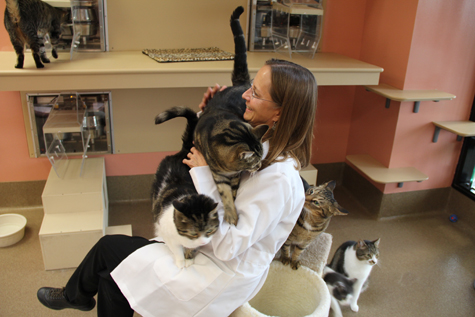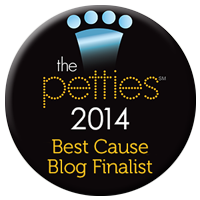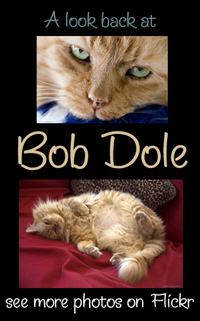
You are here
Hill’s Pet Nutrition Center-The Tour, Part Three
[if you missed part one, you can read it HERE and part two is HERE]
I asked about what happens when a cat gets too old to be tested or develops problems where they can no longer provide good test results. The senior cats were placed in a “retirement” group home that frankly was quite austere. I asked why they couldn’t get adopted out to a family. Their reasoning was that senior cats often developed illnesses that were too costly for adopters to have to pay for so it was not possible to adopt them out. I couldn’t help but think that with all the money Hill's has, the least they could do was to adopt out those cats and give them FREE Vet care for the rest of their life, taking the financial burden off the adopters and giving those cats (and dogs) a graceful end to their life.

©2012 Hill's. Dr. Burris with cats. (used with permission)
When the tour group moved on, I asked one of the employees what they do with cats who have terminal illness. She said they had a cat with mammary gland tumors, but they would not do surgery to remove them. She didn’t know if it was due to the cat's blood test results making it too risky to do the surgery or why their staff Vet decided not to do anything. She didn’t go into whether they’d done chemo for any cats but I heard of a dog getting a surgery to repair a leg injury. I wondered at what point they turned their backs on those animals? Maybe they never do. I can’t speak to that question.
The animals are only subjected to occasional blood draws and yearly dentals. They are not dissected, but they do necropsies after the animal has passed away.
_Zebra.jpg)
©2012 Hill's. Turtle and Zebra (used with permission)
We were told that Hill's took euthanasia very seriously, but in the end, when the animals were put down, they were put into a group cremation and that was all we were told. No, those cats or dogs weren’t someone’s pet and were placed in an urn in a cherished place on the mantel, but each animal is given a name from the moment they enter the facility.
---------------------------------------------
We toured the AAHA (American Animal Hospital Association which was founded in 1933 by a group of Veterinarians-Dr. Mark Morris was one of them) accredited surgical suite and state-of-the-art Vet department. It was spotless, glowing, enormous. They mostly did dental cleanings or spay/neutering. They had every sort of MRI or dual bone density scanner that any Vet would drool over. I couldn’t help but wish they’d open this space up to local rescues for a free Vet clinic a few times a month-just to give back, but how could they? It would bring disease into the building.
We finished the tour of the animal housing and many folks were abuzz about how wonderful the areas were. Maybe it was just me, but I could only think about how every night they turned the lights off and not one of those dogs or cats had a bed to sleep on and a human to sleep with. Was it worth those animals giving up their lives to science when the clinical trials don't seem to be long enough in the first place?

©2012 Hill's. Falstaff. -today they use beagles- (used with permission)
For what it was, their facility is spacious, clean and well lit. The dogs appear to be having a good time, running around outside, barking their little beagle barks. I’m certain the cats and dogs who live in other test facilities have it much, much worse. I think Hill’s did a very good job at creating as comfortable and humane a space as they could.
---------------------------------------------
It was time for the wrap up. Mr. Kontopanos was very eager to hear what we thought about the tour and the presentations. Many folks were on board, but thankfully a few asked some probing questions. Questions like where does your protein come from—factory farms or free range? Answer: Tyson’s for chicken and other places, but then they glossed over the answer, meaning it was probably factory farms. Many pet guardians care about where their own food comes from and they feel the same way about the food they feed their animals. No one wants animals to suffer so where is the leadership in Hill’s opting to use farms that can be certified humane? Perhaps those changes are to come?
I asked Mr. Kontopanos if Hill's was planning on producing a grain-free food since the market has exploded with options-clearly due to consumer buying trends. Mr. Kontopanos paused, looked a bit irritated, then said they would produce one only when they could declare it as “complete balanced nutrition.” I wondered how many times he’d answered this question. Had Hill’s focused too much effort on trying to convince pet owners that corn and other grains are good for their pets while there is a lot of evidence to prove the contrary? [apparently there IS a lone dog food with no grain, but I don’t have info on that at this time].
I didn’t ask about how they felt about people feeding a raw diet. I didn’t have the nerve to go there after seeing a slide earlier in the day that talked about what people feed their pets and raw feeding was considered “unconventional.”
No one else brought it up, either, but I knew a few others felt the same as I did that it was actually appropriate and not unconventional to feed a raw diet.
One of their basic diets for adult cats, Science Diet® Adult Indoor Cat Dry has 5 grains and the only animal protein is Chicken by-product meal (according to the AAFCO consists of the ground, rendered, clean parts of the carcass of slaughtered chicken, such as necks, feet, undeveloped eggs and intestines, exclusive of feathers, except in such amounts as might occur unavoidable in good processing practice). Can you tell me how this is better than a raw diet of ground chicken muscle meat, organs and bones from a known, humane farm with some egg yolks, water, low sodium salt, taurine, etc.?
-----------THE TOUR----------------------------------

©2012 Robin A.F. Olson. My “golden” ticket into the secret world of the Emporia Plant.
©2012 Robin A.F. Olson. Arriving at the Plant.
Early the next morning we toured the Hill's manufacturing plant in Emporia, Kansas (one of a handful around the country, in addition to two in Europe). It was just as spotlessly clean and run by devoted employees as the Pet Nutrition Center campus. There’s very tight security in the plant so we weren’t allowed to take any photos. The place had an odd aroma. I thought it was something like a baked grain, then Teri suggested it smelled like dry food cat barf. Thanks, Teri!

©2012 Robin A.F. Olson. Trying to comfort Teri. “You'll get used to the smell. It's not barf, I hope.”
The Emporia manufacturing plant, built in 2010, achieved its LEED – Silver certification last May. The over 500,000 square foot plant is a closed system where each segment of processing is separated by large corridors so that, for instance, the raw stage of processing can’t contaminate the extruding/“kill stage” and so on. Since the process is closed, there’s less chance for the product to be exposed, but the bad part about that is you don’t SEE the ingredients coming together to form their products.

©2012 Robin A.F. Olson. Vats and stuff.
Basically there were a lot of vats, conduit, pipes and odd sounds. It was a perfect setting to shoot a movie if we hadn’t been bogged down by wearing ear protection, hairnets, lab coats, hard hats and steel-toed covers on our shoes.
This plant produces 500,000 pounds of dry food every day. They run three shifts Monday through Friday. The weekend is for cleaning. All the food is x-rayed to make sure there’s no metal in it. They have extremely high quality standards and points at which they test the product. They deal with 140 ingredients so it must be a daunting task.

©2012 Robin A.F. Olson. More strange equipment.
As our tour entered the warehouse it reminded me of the last scene of Raiders of the Lost Ark where Indiana Jones sees the warehouse where the Ark of the Covenant gets stored. I counted 50 aisles stacked 3 palettes high of bagged dry foods. I couldn’t see how far back it went, but I’d say it filled a football field, at least. I asked to take a photo of the stacks of bags and was denied.
The tour was concluded and we were escorted onto a very plush bus that took us to the airport. It was a fast paced, loaded-with-info tour. I didn’t drink the Kool-Aid®, but the interactions I had with the staff from Hill’s and the folks who were on the tour was very pleasant and respectful. I couldn’t have been treated better.

©2012 Robin A.F. Olson. Dr. Patrick Mahaney, Holistic Veterinarian, super-nice guy and -yes, the same one you've seen on TV - and moi.
There seem to be some very caring, possibly even passionate people who do care about pets at Hill’s, but with all due respect, the way they go about “manufacturing” pet food isn’t something I can get on board with even if “Since 2002, the Hill’s Food, Shelter & Love Program™ has donated more than $240 million worth of Science Diet® brand foods to nearly 1,000 animal shelters nationwide, in every state.” That sounds good until you realize they have a captive audience. The shelter takes the free food and then passes along free samples to adopters, who will, of course, become new Hill's customers.
Hill’s promotional material also states: “It has also helped more than 6 million pets find new homes, and counting.” Though if you ask them to clarify that fact, what is happening is they are taking credit for the adoptions of animals from the shelters they donate food to. Hill’s doesn’t operate any shelters.

©2012 Robin A.F. Olson.
When it’s all said and done Hill’s treated me with respect and provided for my every need. I appreciate their hospitality and their pride in their company and their community.
My wish, if I could have one, would be that they re-think their approach to developing foods for cats and dogs that doesn’t lean so heavily on science and testing, but that focuses on wholesomeness and appropriateness with fewer ingredients and grains.
No one ever said a word about cats being OBLIGATE carnivores and how science could ever supersede that simple fact by using chemicals, cooking, over processing technology and less costly grains to make up for what cats truly need. They need MEAT. That’s how they get their energy, unlike humans, who get it from carbohydrates.
I realize that asking Hill’s to take their multi-billions of dollars and DO THE RIGHT THING with their products is a Herculean undertaking. Even adding ONE ingredient to ONE kind of cat food starts a chain reaction that could take months if not years to implement.
I also “get it” that asking Hill’s to use high quality meat in their food, to throw out the zillion bags of dry food and focus on canned and yes, a line of frozen raw food would be a sourcing nightmare. Where would you GET all this meat? What would happen to all the farmers who you buy your corn, wheat, soy and rice from?
How can you move a behemoth of a company into a new direction when they’ve already spent decades on marketing to convince consumers that science IS the answer, not common sense?
It’s like me telling you to eat a vitamin soaked breakfast bar and tell you it will cover your nutritional needs because it’s “scientifically proven” (because it was tested for up to six months on about 8 humans) and it will allow you to live a long, healthy life. It will give you calories and some nutrition, but in the long haul what is your quality of life? You’ll be alive, but will you thrive? Will your teeth be ruined and will you have skin allergies and lymphoma?

©2012 Robin A.F. Olson.
All I can say is that my hand is held out in friendship to everyone at Hill’s. Take your financial resources, your science, your advertising and DO THE RIGHT THING with it. You know what it is, you just have to turn the rudder a bit. I’ll be waiting for you, ready to shout to the world what wonderful, completely perfect foods you create and that we'll all share the rewards of a longer, healthier, happier life with our pets for all that you do.
Until then, I'm going to respectfully disagree and hope that one day the answer to the question of “What should I feed my cat?” will no longer be so divisive.
©2012 Robin A.F. Olson. A last look at Kansas and touchdown in NYC.


















Comments
Very well done. Respectful
Very well done. Respectful and through.
I will have to disagree with you that humans should get their calories through carbohydrates but I am right there with you on the breakfast bar analogy.
Hills
They do make a grain free cat food - Ideal Balance Grain Free - they have it out for cats and dogs. But it is a tiny fraction of their line, and I know in the store I work in we carry like 3 bags because no one buys it. If a customer opts for grain free they leave Hills.
I follow a lot of cat blogs, it is interesting to see everyone's reactions after they've been on this tour. Thank you for sharing!
Good reporting
Thank you for thorough and informative reporting. I agree with you re feeding meat to obligate carnivores and while long term the financial benefits would be there for a big corporation, sourcing ethically raised/slaughtered meat would be a problem. And I agree with Connie, we don't really need carbs - not processed ones at any rate.
science diet yd
my senior cat Harry is hyperthyroid, and has underlying cardiomyopathy, so getting his thyroid levels to normalize is important in maintaining his cardiac health. He hates taking pills. I have been feeding him (and my nonhyperthyroid Sirius) yd with excellent results. Both cats eat up happily (sirius does get a little extra "regular" 'food to supply his iodine needs) and both are really doing quite well. So I for one would like to thank Hills for this product, which has saved both me and Harry a great deal of unneccessary stress about trying to get him to take meds. (And I am not a vet, and I do not work for any pet food manufacturers either!)
Thank you
Thank you for sharing in detail the tour, your interactions, & your perceptions. I appeciate the time & effort that you put into providing us with information. Great job!
Awesome - Respectful without being Subservient!
Robin, I admit I was concerned when I saw the first part of this series. I've seen others wooed by the pet food industry succumb to their lure and I was worried you would fall under their spell, as well.
I'm delighted to see you give credit where it's due, without once losing sight of the most important factor - the products Hill's produces are unhealthy for our beloved cats. With its ginormous reach and near-bottomless resources, Hill's has the potential of having a huge positive impact on feline health all across America. Change IS hard, but good on you for calling for it!
Good job!
Good post, fun photos, and very in-depth reporting of your thoughts and observations. I wish you had been able to ask some of those questions of the presenters at Hill's so we all could have listened to their responses.
I can't see how they could provide free vet care for the animals they place without running the risk of bringing in disease, just as they would if they did Free Clinics, like you mentioned. How many times have we adopted a pet, sometimes even a special needs pets, knowing that we are accepting the responsibility for it's ongoing care. It is something we do so that pet that might be overlooked can have a loving home...
I think Hill's will come around, but not to the point of producing a raw diet. I think we will have to go to companies like Honest Kitchen and others to meet our needs for a safe raw diet. I know for myself, I do not have the time to make a home made food for my cats, but truly appreciate it that there are companies out there that I can purchase raw from.
In the over the 40 years I have been a vet tech, have seen some positive changes in the direction of Hill's (and other companies) foods, but there will still be the people who want to feed inferior foods they pick just because the bag or the commercial is cute.
It falls upon us as consumers to do our homework and feed what we think is the best for our pets, but just as in humans...talking about the right diet IS very devisive...from Paleo to Atkins and everything in between. But I am glad I did the tour too, and did come home with some new information and am open to learning more about what to feed my cat. I find it quite frustrating that there are quite a number of excellent quality, small batch, whole food ingredient foods out there for dogs (Fresh Fetch, Answers, Carna 4, Lucky Dog) but very few for cats. That kind of speaks for what drives the marketplace..Woof Woof.
Add new comment